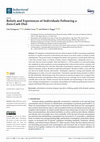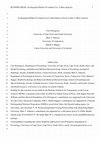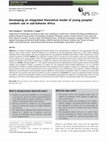Papers by Cleo Protogerou
Psychology & Health, 2008

In this Chapter, we provide a comprehensive presentation of what is known about bullying in schoo... more In this Chapter, we provide a comprehensive presentation of what is known about bullying in schools. We begin with highlighting the epidemiology and nature of bullying, and we proceed with the research findings of hypothesised antecedents and consequences of bullying. Then, we present the anti-bullying intervention programmes, along with a commentary of their effectiveness, and our recommendations for further preventative measures. Throughout the Chapter, we adopt a critical stance towards the international and South African bullying literature, pointing out strengths and deficits of the theories, research methods, and practical applications employed. We concur that investigators must carefully synthesise existing theoretical and empirical information and use it as a basis for developing anti-bullying programmes. To be efficacious, preventative efforts need to be theory-driven, data-driven, and subjected to rigorous evaluation. keywords: bullying at schools, risk-factors, prevention...

Background. We aimed to develop an integrated theoretical model of the determinants of condom use... more Background. We aimed to develop an integrated theoretical model of the determinants of condom use in young people from sub-Saharan African (SSA) nations. Model development was informed by research predicting condom use in SSA nations adopting individual-level social-cognitive and socio-ecological theories, and guided by McMillan and Conner’s (2007) framework of social-cognitive predictors of health. Methods. We conducted a scoping review of research on social-cognitive and socio-ecological predictors of condom use in young people in SSA. The integrated model was developed based on the constructs from the review and using McMillan and Conner’s framework as guide to classify the constructs and isolate the processes by which the constructs impact condom use. Findings. Included studies (N=45) utilised constructs from seven individual-level social-cognitive theories and included multiple socio-ecological variables as predictors of condom use. The integrated model included dispositions to...

Behavioral Sciences
The adoption of carbohydrate-restrictive diets to improve health is increasing in popularity, but... more The adoption of carbohydrate-restrictive diets to improve health is increasing in popularity, but there is a dearth of research on individuals who choose to severely restrict or entirely exclude carbohydrates. The present study investigated the beliefs and experiences of individuals following a diet that severely limits, or entirely excludes, dietary carbohydrates, colloquially known as a ‘zero-carb’ diet, for at least 6 months. Zero-carb dieters (n = 170) recruited via a social networking site completed an online qualitative survey prompting them to discuss their motives, rationale, and experiences of following a low-carb diet. Transcripts of participants’ responses were analyzed using inductive thematic analysis. Results revealed that participants’ decision to follow a zero-carb diet was driven by health concerns and benefits. Participants expressed a strong social identity and belongingness to online zero-carb communities. Participants reported strong intentions to follow the die...

Background: While predominant dietary guidelines promote foods low in fat and high in carbohydrat... more Background: While predominant dietary guidelines promote foods low in fat and high in carbohydrates, evidence links high carbohydrate consumption to adverse health effects in populations that are metabolically challenged by (pre)diabetes or metabolic syndrome. An increasing number of people report eating diets that limit carbohydrates. These diets are known as low carb or ketogenic diets. There is emerging advocacy of a specific variant of a ketogenic diet, the zero-carb diet, which aims to severely limit, or even exclude entirely, carbohydrate consumption. However, little empirical research has been dedicated to exploring the determinants of zero-carb diets and the views of the people that follow them. Objective: This study aimed to investigate the perspectives and experiences of people following zero-carb diets for at least 6 months. The study also aimed to elicit the salient beliefs that shape uptake and adherence to the diet. Methods: Zero-carb dieters (N = 170) recruited from a...

Background: Sub-Saharan African nations continue to carry the substantive burden of the HIV pande... more Background: Sub-Saharan African nations continue to carry the substantive burden of the HIV pandemic, and therefore, condom use promotion is a public health priority in that region. To be successful, condom promotion interventions need to be based on appropriate theory. Objective: To develop and test an integrated theory of the determinants of young peoples’ condom use in Sub-Saharan Africa, using meta-analytic path analysis. Method: Theory development was guided by summary frameworks of social-cognitive health predictors, and research predicting condom use in SSA, adopting social-cognitive theories. Attitudes, norms, control, risk perceptions, barriers to condom use, intentions, and previous condom use, were included in our condom use model. We conducted an exhaustive database search, with additional hand-searches and author requests. Data were meta-analyzed with Hedges and Vevea’s (1998) random-effects models. Individual, societal, and study-level parameters were assessed as candi...

Health Psychology Review
ABSTRACT Self-regulation is a key antecedent of health and behaviour-change interventions have ut... more ABSTRACT Self-regulation is a key antecedent of health and behaviour-change interventions have utilised self-regulation approaches to promote health. The present study used a novel methodology, a nested meta-review, to: (a) integrate and summarise information from evidence syntheses of diverse self-regulation interventions to reduce risk-taking, in the behavioural domains of smoking, alcohol and drug use, unhealthy eating, externalising problem behaviours, and sexual risk-taking; (b) identify intervention features implicated in risk-taking prevention or reduction; and (c) provide recommendations for future research and practice. Searches of eight databases yielded 21 eligible evidence syntheses, 15 taking a primarily social-cognitive strategy (k = 1,103 total studies), and 6 taking a primary trait/developmental strategy (k = 119); total N > 650,000. Intervention features most frequently associated with reduced risk-taking included: delivery of multiple components through (either, or a mix of) group, individual, computer, and one-one-one delivery; screening and pharmacotherapy, where relevant; targeting only one behavioural outcome; provision of counselling, stress-management, skills-training, self-monitoring, self-control and impulsivity training, and personalised feedback; identification of barriers and ‘resolution’ of barriers; tailoring to age and ethnicity; and, also, incorporating social support by peers. Some of these patterns were more visible in meta-analyses with higher methodological quality. Recommendations for research and practice are offered.

Health Psychology
Objective: We tested an integrated social cognitive model derived from multiple theories of the d... more Objective: We tested an integrated social cognitive model derived from multiple theories of the determinants of young peoples' condom use in Sub-Saharan Africa. The model comprised seven social cognitive antecedents of condom use: Attitudes, norms, control, risk perceptions, barriers, intentions, and previous condom use. Methods: We conducted a systematic search of studies including effects between at least one model construct and intended or actual condom use in young people from sub-Saharan African countries. Fifty-five studies comprising 72 independent data sets were included and subjected to random-effects meta-analysis. Demographic and methodological variables were coded as moderators. Hypotheses of the integrated model were tested using meta-analytic structural equation modeling. Results: The meta-analysis revealed significant non-trivial sample-weighted correlations among most model constructs. Moderator analyses revealed differences in six correlations for studies that included a formative research component relative to studies that did not. There was little evidence of systematic moderation of relations among model constructs by other candidate moderators. Metaanalytic structural equation models revealed significant direct effects of attitudes, norms, and control on condom use intentions, and of intention, control, and barriers on condom use. Including past condom use increased explained variance in condom use intentions and behavior but did not attenuate model effects. There were also significant indirect effects of attitudes, norms, and control on condom use through intentions. Conclusions: Findings provide preliminary evidence to support the integrated condom use model in sub-Saharan African youth. The model provides guidance on potential targets for improving the effectiveness of condom promotion interventions.

Objective: We aimed to develop an integrated theoretical model of the determinants of condom use ... more Objective: We aimed to develop an integrated theoretical model of the determinants of condom use in young people from sub-Saharan African (SSA) nations. Model development was informed by research predicting condom use in SSA nations adopting individual-level social-cognitive and socio-ecological theories, and guided by McMillan and Conner's (2007) framework of social-cognitive predictors of health. Method: We conducted a scoping review of research on social-cognitive and socio-ecological predic-tors of condom use in young people in SSA. The integrated model was developed based on the constructs from the review and guided by McMillan and Conner's framework to classify the constructs and isolate the processes by which the constructs impact condom use. Results: Included studies (N = 45) utilised constructs from seven individual-level social-cognitive theories and included multiple socio-ecological variables as predictors of condom use. The integrated model included dispositions to act as a proximal determinant of condom use which mediated the effect of four categories of social-cognitive constructs on condom use: attitudes, control perceptions, norms, and self-representations. Socio-ecological factors were classified into four categories: relational, individual differences, societal/structural, and community and peer influences. Each had direct and indirect effects on condom use in the model, reflecting the non-conscious and conscious pathways to action, respectively. Conclusion: We expect our integrated model to provide an evidence-and theory-based guide to future research examining the antecedents of condom use in young people in SSA. We also anticipate it will assist in developing targets for interventions that will be effective in promoting condom use in this population.

Journal of Psychology in Africa, Oct 28, 2014
ABSTRACT & link to free access e-print: http://www.tandfonline.com/eprint/UMdi8jaYAWm2Y3C... more ABSTRACT & link to free access e-print: http://www.tandfonline.com/eprint/UMdi8jaYAWm2Y3CPe3I3/full This study aimed to investigate contextual influences on condom use by South African university students. Twenty one-to-one, semi-structured interviews were conducted with male and female South African undergraduates. The data were thematically analysed. Results revealed that condom use was transient and often unrelated to disease prevention. Condom use was impeded by closer perceived intimacy, gender dynamics, and social stigma against proposing use of condoms in a presumably committed relationship. Public health policies regarding condom, pill and injection pricing / promotion, and religious toleration also hampered condom use, by encouraging a preference over hormonal contraception or proscribing contraceptive measures altogether. The results provide a basis for considering the impact of immediate and wider social contexts on condom use, as proposed by socio-ecological models of HIV risk behaviour.

In this Chapter, we provide a comprehensive presentation of what is known about bullying in schoo... more In this Chapter, we provide a comprehensive presentation of what is known about bullying in schools. We begin with highlighting the epidemiology and nature of bullying, and we proceed with the research findings of hypothesised antecedents and consequences of bullying. Then, we present the anti-bullying intervention programmes, along with a commentary of their effectiveness, and our recommendations for further preventative measures. Throughout the Chapter, we adopt a critical stance towards the international and South African bullying literature, pointing out strengths and deficits of the theories, research methods, and practical applications employed. We concur that investigators must carefully synthesise existing theoretical and empirical information and use it as a basis for developing anti-bullying programmes. To be efficacious, preventative efforts need to be theory-driven, data-driven, and subjected to rigorous evaluation.

Journal of Psychology in Africa
& link to free access e-print: http://www.tandfonline.com/eprint/UMdi8jaYAWm2Y3CPe3I3/full This s... more & link to free access e-print: http://www.tandfonline.com/eprint/UMdi8jaYAWm2Y3CPe3I3/full This study aimed to investigate contextual influences on condom use by South African university students. Twenty one-to-one, semi-structured interviews were conducted with male and female South African undergraduates. The data were thematically analysed. Results revealed that condom use was transient and often unrelated to disease prevention. Condom use was impeded by closer perceived intimacy, gender dynamics, and social stigma against proposing use of condoms in a presumably committed relationship. Public health policies regarding condom, pill and injection pricing / promotion, and religious toleration also hampered condom use, by encouraging a preference over hormonal contraception or proscribing contraceptive measures altogether. The results provide a basis for considering the impact of immediate and wider social contexts on condom use, as proposed by socio-ecological models of HIV risk be...
This study was carried out among university undergraduates in Cape Town, South Africa. Structural... more This study was carried out among university undergraduates in Cape Town, South Africa. Structural equation models were tested with Mplus to predict intentions to use condoms and actual (subsequent) condom use. Theory of planned behavior (TPB) predictors (attitudes, subjective norms, perceived behavioral control) explained 43% of the variance of intention to use condoms among the sexually active sample, and 31% among the sexually inactive. In a separate analysis-which also included intentions and previous condom use as predictors-57% of subsequent condom use among the sexually active students was explained. Moreover, age, religiosity, and relationship status were associated with condom use. Our findings provide support for the applicability and suitability of the TPB in South African student populations.

ABSTRACT Background: Behavioural interventions for reducing HIV risk behaviour have been evaluate... more ABSTRACT Background: Behavioural interventions for reducing HIV risk behaviour have been evaluated for adolescents. These trials have had conflicting results, and prior meta-analyses have not examined whether important structural dimensions account for these differences. Methods: 139 intervention trials from 22 nations were retrieved; efficacy was assessed using HIV knowledge, condom use, or abstinence at trials’ last available assessment. Findings: Interventions were more successful increasing knowledge in nations with relatively low health-care expenditures (β = .21), a pattern that remained even when controlling for nations’ human development index (HDI) levels, respect for human rights, and contraceptive preferences. Condom use efficacy increased marginally in nations with higher HDI (β = -.12). These dimensions were unrelated to efficacy as gauged by abstinence. Discussion: Intervention efficacy appears to depend on social-structural elements present in the larger environment in which the interventions are delivered. Future research could investigate how these elements interact with intervention and sample features.

Cardiac surgery patients may be provided with psychological interventions to counteract depressio... more Cardiac surgery patients may be provided with psychological interventions to counteract depression and anxiety associated with surgical procedures. This systematic review and meta-analysis investigated whether intervention efficacy was impacted by type of cardiac procedure/cardiac event; control condition content; intervention duration; intervention timing; facilitator type; and risk of bias. MEDLINE, EMBASE, and PsycINFO were searched for randomized controlled trials comparing anxiety and depression outcomes, pre and post psychological and cardiac interventions. Twenty-four studies met the inclusion criteria for the systematic review (N ¼ 2718) and 16 of those were meta-analysed (N ¼ 1928). Depression and anxiety outcomes were reduced more in interventions that lasted longer, were delivered post-surgery, and by trained health professionals. Depression (but not anxiety) was reduced more when the experimental intervention was compared to an 'alternative' intervention, and when the intervention was delivered to coronary artery bypass graft patients. Anxiety (but not depression) was decreased more when interventions were delivered to implantable cardioverter defibrillator patients, and were of 'high' or 'unclear' risk of bias. In addition to estimating efficacy, future work in this domain needs to take into account the moderating effects of intervention, sample, and study characteristics.

AIDS and behavior, 2014
The purpose of this meta-review was to identify characteristics of successful HIV prevention inte... more The purpose of this meta-review was to identify characteristics of successful HIV prevention interventions for adolescents based on quantitative (i.e., meta-analyses) and qualitative reviews published to date, and to inform intervention utilization and future development. To that end, we were guided by principles of triangulation. Searches of seven electronic bibliographic databases yielded five meta-analyses and six qualitative reviews that satisfied the selection criteria. Reviews were subjected to careful content analysis. All reviews reported that behavioral interventions had positive outcomes on at least one of the following outcomes: HIV-related knowledge, subjective cognitions and beliefs enabling safer sex, abstinence, delaying next sexual intercourse, decreasing number of sexual partners, and actual condom use. Four categories, suggesting factors more prominently linked to intervention success, emerged: behavior change techniques (e.g., cognitive-behavior and motivation enh...










Uploads
Papers by Cleo Protogerou